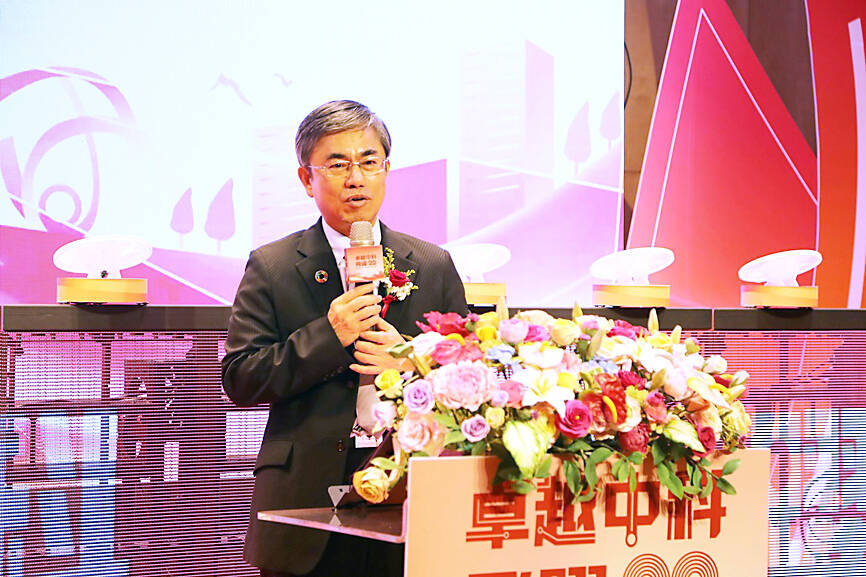Taiwan Semiconductor Manufacturing Co (TSMC, 台積電) plans to begin construction of four new plants later this year, with the aim to officially launch production of 2-nanometer semiconductor wafers by late 2028, Central Taiwan Science Park Bureau director-general Hsu Maw-shin (許茂新) said.
Hsu made the announcement at an event on Friday evening celebrating the Central Taiwan Science Park’s 22nd anniversary.
The second phase of the park’s expansion would commence with the initial construction of water detention ponds and other structures aimed at soil and water conservation, Hsu said.

Photo: courtesy of the Central Taiwan Science Park Administration Office
TSMC has officially leased the land, with the Central Taiwan Science Park having handed over the plot last month, he added.
Hsu said he is optimistic that the park’s annual turnover would surpass NT$1.2 trillion (US$40.81 billion), setting a new historic high.
At the North America Technology Symposium in California on April 25, TSMC revealed plans to launch its A14 fabrication processes in 2028.
The four plants in the Central Taiwan Science Park, designated Fab 25, would feature four 1.4-nanometer wafer manufacturing facilities, according to TSMC’s roadmap.
The first plant is expected to complete a risk assesment of wafer production by 2027 and begin mass production by late 2028, with a target monthly output of 50,000 wafers, according to the company’s roadmap.
At the TSMC second-quarter earnings conference and conference call on Thursday, TSMC chairman C.C. Wei (魏哲家) said that after the completion of the company’s US$165 billion investment in the US, “about 30 percent of our 2-nanometer and more advanced capacity will be located in Arizona, creating an independent leading-edge semiconductor manufacturing cluster in the US.”
The Arizona investment includes six advanced wafer manufacturing fabs, two advanced packaging fabs and a major research and development center.
Wei also said that TSMC is planning “to build 11 wafer manufacturing fabs and four advanced packaging facilities over the next several years.”
The company is “preparing for multiple phases of 2-nanometer fabs at the Hsinchu and Kaohsiung science parks to support the strong structural demand from our customers,” Wei said.

A magnitude 7.0 earthquake struck off Yilan at 11:05pm yesterday, the Central Weather Administration (CWA) said. The epicenter was located at sea, about 32.3km east of Yilan County Hall, at a depth of 72.8km, CWA data showed There were no immediate reports of damage. The intensity of the quake, which gauges the actual effect of a seismic event, measured 4 in Yilan County area on Taiwan’s seven-tier intensity scale, the data showed. It measured 4 in other parts of eastern, northern and central Taiwan as well as Tainan, and 3 in Kaohsiung and Pingtung County, and 2 in Lienchiang and Penghu counties and 1

A car bomb killed a senior Russian general in southern Moscow yesterday morning, the latest high-profile army figure to be blown up in a blast that came just hours after Russian and Ukrainian delegates held separate talks in Miami on a plan to end the war. Kyiv has not commented on the incident, but Russian investigators said they were probing whether the blast was “linked” to “Ukrainian special forces.” The attack was similar to other assassinations of generals and pro-war figures that have either been claimed, or are widely believed to have been orchestrated, by Ukraine. Russian Lieutenant General Fanil Sarvarov, 56, head

FOREIGN INTERFERENCE: Beijing would likely intensify public opinion warfare in next year’s local elections to prevent Lai from getting re-elected, the ‘Yomiuri Shimbun’ said Internal documents from a Chinese artificial intelligence (AI) company indicated that China has been using the technology to intervene in foreign elections, including propaganda targeting Taiwan’s local elections next year and presidential elections in 2028, a Japanese newspaper reported yesterday. The Institute of National Security of Vanderbilt University obtained nearly 400 pages of documents from GoLaxy, a company with ties to the Chinese government, and found evidence that it had apparently deployed sophisticated, AI-driven propaganda campaigns in Hong Kong and Taiwan to shape public opinion, the Yomiuri Shimbun reported. GoLaxy provides insights, situation analysis and public opinion-shaping technology by conducting network surveillance

‘POLITICAL GAME’: DPP lawmakers said the motion would not meet the legislative threshold needed, and accused the KMT and the TPP of trivializing the Constitution The Legislative Yuan yesterday approved a motion to initiate impeachment proceedings against President William Lai (賴清德), saying he had undermined Taiwan’s constitutional order and democracy. The motion was approved 61-50 by lawmakers from the main opposition Chinese Nationalist Party (KMT) and the smaller Taiwan People’s Party (TPP), who together hold a legislative majority. Under the motion, a roll call vote for impeachment would be held on May 19 next year, after various hearings are held and Lai is given the chance to defend himself. The move came after Lai on Monday last week did not promulgate an amendment passed by the legislature that